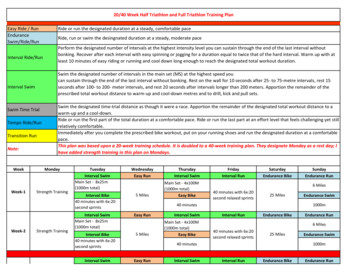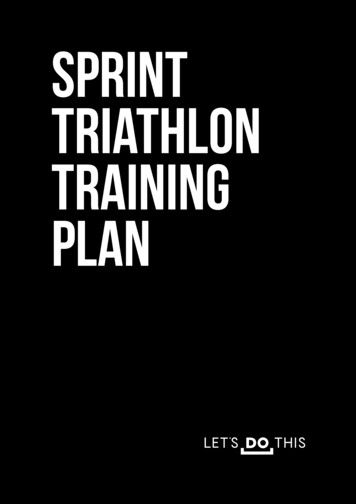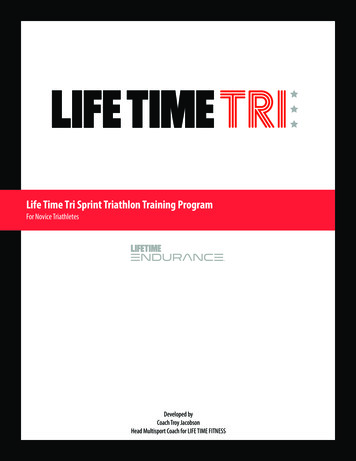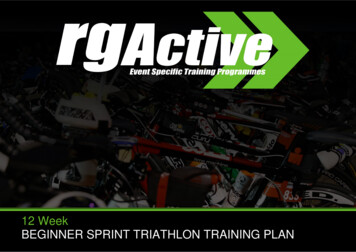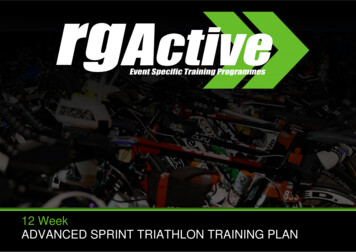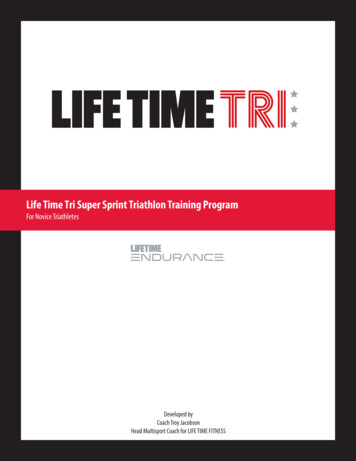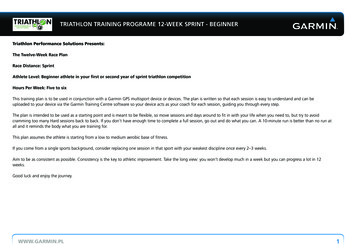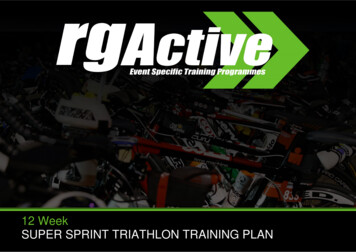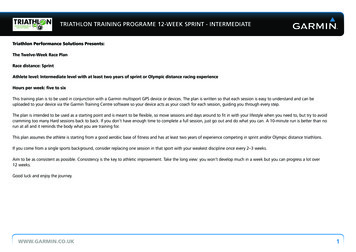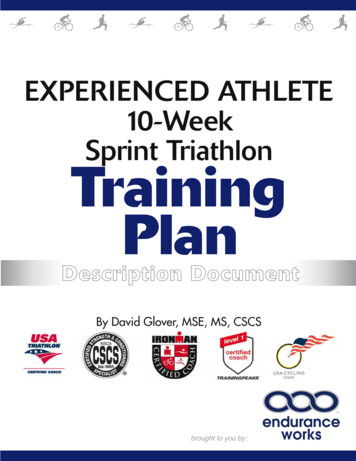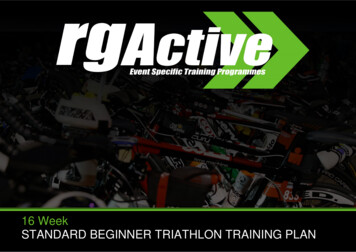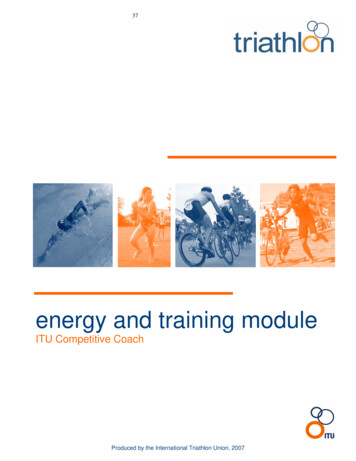
Transcription
37energy and training moduleITU Competitive CoachProduced by the International Triathlon Union, 2007
38
39energy & training Have you ever wondered why some athletes shoot off the start line while otherstake a moment to react? Have you every experienced a “burning” sensation in your muscles on the bike? Have athletes ever claimed they could ‘keep going forever!’?All of these situations involve the use of energy in the body. Any activity the bodyperforms requires work and work requires energy. A molecule called ATP(adenosine triphosphate) is the “energy currency” of the body. ATP powers mostcellular processes that require energy including muscle contraction required forsport performance.Where does ATP come from and how is it used?ATP is produced by the breakdown of fuel molecules—carbohydrates, fats, andproteins. During physical activity, three different processes work to split ATPmolecules, which release energy for muscles to use in contraction, force production,and ultimately sport performance. These processes, or “energy systems”, act aspathways for the production of energy in sport. The intensity and duration ofphysical activity determines which pathway acts as the dominant fuel source.Immediateenergy systemFuel sourcesATPE.g. carbohydrates,proteins, fatsenergy“currency”Short termenergy systemSportperformanceE.g. swimming, cycling,running, transitionsLong termenergy system1During what parts of a triathlon might athletes use powerful, short, bursts of speed?2What duration, intensity, and type of activities in a triathlon cause muscles to “burn”?3When in a triathlon do athletes have to perform an action repeatedly for longer than 10 or 15minutes at a moderate pace?
40energy systemsLong Term (Aerobic) SystemThe long term system produces energy through aerobic (with oxygen) pathways.This system is dominant at lower intensities and efforts lasting longer than 2 to 3minutes. Production of energy, or ATP, occurs in the mitochondria of the musclefibers. Mitochondria contain special enzymes that permit the breakdown of fuels (e.g.glycogen, fatty acids) through interaction with oxygen to produce large amounts ofenergy. Training the aerobic system increases the number and size of themitochondria, making the muscles more efficient at using oxygen for fuel.Short Term (Anaerobic Lactic) SystemAs intensity increases, it becomes increasingly difficult for the body to provide enoughoxygen to fuel aerobic pathways. The short term, or anaerobic lactic (without oxygen,with lactic acid) system begins to contribute more energy to fuel the muscle. Fuel forthis system comes from glucose in the blood and stored glycogen in the muscle.Along with energy (ATP), lactic acid is produced as a byproduct of this system. Asexercise intensity increases, so does the accumulation of lactic acid in the blood andmuscles. If this accumulation becomes too high, then the short term system cannotcontinue. At maximum intensity, this system is exhausted within 60 to 120 seconds.Athletes experience shortness of breath, pain (burning sensation), and weakness inthe muscles.In triathlon, the aerobic and anaerobic lactic systems often operate in tandem, withenergy being supplied through both pathways as intensities fluctuate. A well-trainedaerobic system allows athletes to perform at higher intensities before lactic acidbuilds up and recover faster after hard efforts.The Immediate (Anaerobic Alactic) SystemWhen sudden, explosive or immediate movements are required, a third systemproduces ATP at a very high rate. The anaerobic alactic (without oxygen, withoutlactic acid) or ATP-CP system is fueled by stored ATP and another high energysubstance, creatine phosphate (CP). Because these fuel stores are relatively small,the immediate system only supplies energy for up to about 10 seconds of highintensity activity. ATP-CP stores can be replenished in a few minutes of rest. Duringa triathlon this system is dominant during races starts, very explosive movements likeflying bike mounts, and accelerations or surges that are less than 10 seconds induration.Energy System IntegrationThe energy systems do not work independently. During exercise, all the systems operatesimultaneously in different degrees, depending on the energy demands placed on thebody. During a triathlon, the long term system is dominant, but the immediate and shortterm systems are accessed when an athlete increases their intensity. While a majority ofthe triathlete’s training will rely on the long-term system for energy, some training (starts,surges, and fast repeats) should make use of the immediate and short-term systems.This type of balanced training will lead to improvements in maximum oxygen uptake andwork efficiency; more work done at less cost.
41EnergySystemAerobic(long term)Anaerobic Lactic(short term)Anaerobic Alactic(immediate)Fuel SourceCirculated nutrients(oxygen as a catalyst)Glycogen (stored carbohydrates) inthe muscle and liverStored ATP and CP(creatine phosphate)Limit of fuelsourceThe body’s ability to processoxygen.At 100% intensity; 10 seconds to 2minutesUp to 10 seconds*the limiting factor at maximumintensity is the build up of lactic acid,not the depletion of glycogen storesByproductsATP, CO2, H2OATP, Lactic acidATP, CreatineIntensity ofexercisewhen systemis dominantLow to moderate; higherintensities for efforts lastinglonger than 2 minutesHigh to very high for longer than 10secondsVery high intensity;explosive movements*significant overlap withanaerobic system at higherintensities for events longerthan 2 minutes(up to 2 or 2.5 minutes at maximumintensity)(up to 10 seconds, unlessstores have time toreplenish)Recovery offuel storesafter useHighly dependent on intensity.Rate of lactic acid removal25% in 10 minutes50% in 25 min.100% in 75 min.50% replenished in 30secondsLower intensity, 6 to 24 hours.Higher intensity, 24 to 36 hours.*low intensity exercise can help“flush” lactic acid out of the musclesand facilitate faster recovery2 minutes for completerestoration (if resting)Replenishment of glycogen*following continuous, high intensityendurance activities60% in 10 hours100% in 48 hoursReplenishment of glycogen*following intermittent activity40% in 2 hours55% in two hours100% in 24 hours*in order to replenish glycogen stores,athletes must consume carbohydraterich foodsAthleticabilitiesdeveloped bytraining thissystemAerobic power (highestintensity that still involves theaerobic (oxygen) system)Aerobic endurance (ability ofthe body to supply muscleswith oxygen for long periods)Muscular endurance (repeatedmuscle contractions)Speed (moving as fast as possible;10 seconds to 2 minutes)Power (moving againstresistance or a force asfast as possible)Maximum speed (up to10 seconds)Muscular enduranceUse intriathlonDominant system in triathlon;all components.Supplement to aerobic activity athigh intensities (e.g. surges,accelerations, longer than 2min)First two minutes of higher intensityactivity within the race (e.g. first 100200m of the swim).Race starts, surges, rapidaccelerations and/orpower increases up to 10seconds
42The diagram below is a hypothetical “energy chart” of an athlete completing a sprint distance triathlon. The lighter region at the bottom represents the aerobic, or long term system. This system is dominantthroughout the race. The darker grey represents the anaerobic lactic system. As athletes increase intensity, for example,cycling or running uphill, they will start to use more anaerobic energy pathways. The black region at the top of the graph represents the anaerobic alactic system. Athletes activate thissystem for only very short periods at extremely high intensities—for example starting a race.The span of systems an athlete utilizes during a triathlon event illustrates why it is important to balance trainingusing a variety of intensities. After developing an aerobic base of fitness and strength, training should bedesigned to condition athletes for the specific demands of their event.Energy Use: Sprint Distance Triathlon (750m swim, 20km cycle, 5km run)Immediate system (anaerobic alactic)Short term system (anaerobic lactic)Long term system o T-1(run)T-1 &bikemountBike(flats)Bike(rolling m)51-5253-5859-7071-72Race Components and Terrain0-22-101112-141516-2020-3030-50Total Race Time (in minutes)Energy Use: Olympic Distance Triathlon (1.5km swim, 40km cycle, 10km run)Based on the information you now know about energy systems, draw your own interpretation of an athlete’s energyuse (during an Olympic Distance triathlon) on the chart below.Immediate system (anaerobic alactic)Short term system (anaerobic lactic)Long term system mexit(beach)BikeBike100m(racing toto T-1 mountkeep up withandandanotherT-1 start ofathlete)cycleBike(5 steephills;accents anddescents)Bike(flat, slightlyrolling, 4surges of 1015 sec. each)T-2FinishRun(1km flat)1km uphillFlat for 3km;2km on trails;2km slight downhill;1km with 3x100m steep hillsRace Components and Terrain0-22-2222-2324-2627-3536-4647-7071-95Total Time (in minutes)96-9798-138139-143
43Create your own energy use diagram for a race distance of your choice. Label the terrain, components of thecourse, and time for each. When you have completed the diagram, swap with another coach and analyze eachof your races. Would you change anything based on your discussion?Energy Use: Distance Triathlon ( swim, cycle, run)Immediate system (anaerobic alactic)Short term system (anaerobic lactic)Long term system (aerobic)IntensityhighlowRace Components and TerrainTotal Race Time (in minutes)training the energy systemsThere are more and less formal methods of training the energy systems. However, it is important to realize thatMANY variables affect how well these methods work. There is no “one right way” to train each energy system.Every athlete will respond differently to training depending on age, ability, past training, morphology (body type),physiology (e.g. muscle fiber type), character, mental state, motivation, skill level, and other variables.Before moving on to more formal methods of training, use the chart below to brainstorm some creative methodsof training each energy system, based on the information you already know. Just as the body uses a blend ofenergy systems within a race, training also involves a combination of energy systems within practices.Immediate system(Anaerobic Alactic)E.g. practice multiple swim starts withseveral minutes rest betweenShort term system(Anaerobic Lactic)E.g. After a 15 min. warm-up, cycle spurtsof 2-3 minutes very fast with easy riding torecover in betweenE.g. flying bike mount 200m power cycling E.g. ride repetitions of hills (1-2 minutes(standing up)each with several minutes rest between)Long Term system(Aerobic)E.g. run for 60 minutes at ‘talkingpace’ (easy intensity)E.g. after a warm-up, do a 15 min. hardcycle at “race pace”
44general training guidelinesFormal training of the energy systems is part science and part art. Coaches must take intoconsideration the science of “what system to train, when, and how often” with the individual needsand capacities of each athlete. Novice athletes require different variations of training, with a focus onthe aerobic system for the first two to three years they are in triathlon. Below are some GENERALguidelines for training each system.There are derivatives of the energy systems that you might be familiar with such as speed, power,endurance, and strength. These terms refer to athletic abilities or components of fitness thatdifferent train aspects of the energy systems and other systems in the body concurrently. Moreinformation on these holistic concepts will be introduced later in this module.Number ofsessions perweekAerobicsystemAerobic-anaerobicmixed systems(lower intensities)(high intensities for longerthan 2 min.)3 to 5 times a weekRecovery6 to 36 hourstime betweensessionsDuration ortimeLonger than 15minutes per intervalor segmentAnaerobicsystemAnaerobicAlacticsystem1 to 2 times a week2 to 3 times a week1-2 times a week24 to 48 hours24 to 36 hours24 to 48 hours10 to 30 minute efforts(moderate to high intensity)20 seconds to 2 minuteintervals5 to 10 secondintervals4 to 12 repetitions8 to 18 repetitions2 to 10 minutesWork: Rest ratio1 : 0.5 or 1:1 or 1:1.560 seconds to 8 minutes.Work : Rest ratio1 : 3 or 420 seconds to 5minutes(e.g. for a 5 min. interval, athletesrest for 2.5 minutes, 5 minutes or 7.5minutes)(e.g. for a 1 min. interval,athletes rest for 3 or 4 min.)2 to 10 minutes (shorter,higher intensity efforts)Number ofintervals orrepetitionsUsually just onerepetition perpractice (e.g. a longrun)Rest between N/AintervalsIntensity1 for 10-30 min. efforts2 to 10 repetitionsfor 2-10min. effortsEasy pace toRace pace to near maximummoderate pace (able effortto talk—slightly outof breath but notlabouring)Near maximum effort(usually training is done insets—groups of 4 to 6efforts—with 30-60 sec.between efforts followed by3-5 min. between sets toallow ATP stores toreplenish)Explosive, maximumeffortHow do you think these training recommendations will differ for novice athletes (1-2 years inthe sport) and intermediate level athletes (2-5 years in the sport)?
45In the chart below, design a workout or activity to train each system in each of the sports. As youapply the general guidelines, consider how you might be more creative and innovative in applyingthese guidelines to designing activities. Throughout your coaching career, you will continue toexpand your knowledge of these systems, their application and how each athlete adapts to training.Aerobic system Aerobic-anaerobic(lower intensities)mixed systems(high intensities for longerthan 2 bicAlacticsystem
46triathlon energyNow that you have some knowledge of the energy systems and ho
Training the aerobic system increases the number and size of the mitochondria, making the muscles more efficient at using oxygen for fuel. . Energy Use: Sprint Distance Triathlon (750m swim, 20km cycle, 5km run) Start (at water edge) swim Swim exit (beach) 100m to T-1 and T-1 Bike mount and start of cycle Bike (racing to keep up with another athlete) Bike (5 steep hills; accents and descents .
